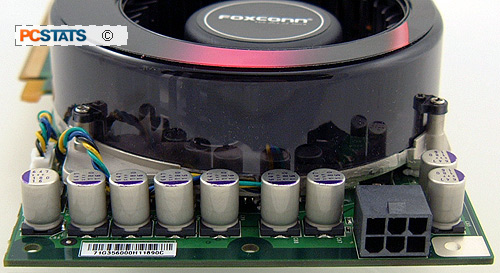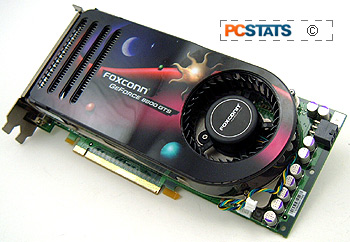While Intel and AMD have moved aggressively towards
reducing the amount of power their processors consume, nVIDIA and ATi have
largely neglected this issue. In fact under load it's possible for videocard
GPUs to suck up more power than the CPU draws. With the nVidia G80 core built on
TSMC's 90nm technology, you know this graphics card is going to consume a lot of
power.
While we have no way of measuring directly how much
power the Foxconn FV-N88SMCD2-ONOC uses, PCSTATS will measure total system power draw
and compare the same basic installation with a couple different videocards to
get a rough idea of how power consumption fluctuates for each specific
videocard.

The test system will consist of an AMD Athlon64 FX-62, Asus M2-CROSSHAIR motherboard, a reference Athlon64 FX-62
cooler, 2GB of Corsair Twin2X2048-6400C3 memory, a 74GB WD Raptor SATA hard drive, an 8x Gigabyte DVD writer and a floppy drive. The Power supply
used here is nice little A-PFC compliant Seasonic S12-600W.
The videocards that will be tested against the Foxconn
FV-N88SMCD2-ONOC will come from both the nVIDIA and ATi camps.
Representing nVIDIA are the MSI NX8800GTX-T2D768E-HD (GeForce 8800GTX), MSI NX7950GX2-T2D1GE (GeForce 7950GX2), a MSI NX7900GTX-T2D512E (GeForce 7900GTX) and a Gigabyte GV-NX76T256D-RH (GeForce 7600GT) videocard.
Representing ATi are an Asus X1900XTX 2DHTV/512M/A (Radeon X1900 XTX) and an Asus EAX1950PRO/HTDP/256M/A (Radeon X1950 Pro)
videocard.
Let's have a look now at the results, just remember the Watts value is total
system power draw. Lower numbers are best.
videocard Power Consumption on Total System Power
Draw Tests Power Consumption on Total System Power
Draw Tests |
| Idle: |
Watts* |
Ranking |
| MSI
NX8800GTX-T2D768E-HD |
196 |
   |
| MSI
NX7950GX2-T2D1GE |
183 |
   |
| MSI
NX7900GTX-T2D512E |
165 |
   |
|
| Gigabyte
GV-NX76T256D-RH |
140 |
   |
| Asus EAX1900XTX
2DHTV/512M/A |
160 |
   |
| Asus
EAX1950PRO/HTDP/256M/A |
150 |
   |
 Foxconn FV-N88SMCD2-ONOC Foxconn FV-N88SMCD2-ONOC |
171 |
   |
 Foxconn FV-N88SMCD2-ONOC (Overclocked to
650/2000) Foxconn FV-N88SMCD2-ONOC (Overclocked to
650/2000) |
178 |
   |
| Load: |
Watts* |
Ranking |
| MSI
NX8800GTX-T2D768E-HD |
345 |
   |
| MSI
NX7950GX2-T2D1GE |
315 |
   |
| MSI
NX7900GTX-T2D512E |
277 |
   |
| Gigabyte
GV-NX76T256D-RH |
213 |
   |
| Asus EAX1900XTX
2DHTV/512M/A |
333 |
   |
| Asus
EAX1950PRO/HTDP/256M/A |
252 |
   |
 Foxconn
FV-N88SMCD2-ONOC Foxconn
FV-N88SMCD2-ONOC |
302 |
   |
 Foxconn FV-N88SMCD2-ONOC (Overclocked to
650/2000) Foxconn FV-N88SMCD2-ONOC (Overclocked to
650/2000) |
317 |
   |
[ *This figure represents total
system power consumption in Watts, either with the system at idle, or the peak
value recorded while running 3DMark06. ]
 At idle, the
Foxconn FV-N88SMCD2-ONOC videocard draws 171W of power at stock speeds, and 178W
when overclocked. The FV-N88SMCD2-ONOC is not very efficient
but then again neither nVIDIA nor ATi has done much to address this
issue of power consumption with current generation GPUs.
At idle, the
Foxconn FV-N88SMCD2-ONOC videocard draws 171W of power at stock speeds, and 178W
when overclocked. The FV-N88SMCD2-ONOC is not very efficient
but then again neither nVIDIA nor ATi has done much to address this
issue of power consumption with current generation GPUs.
The MSI
NX7950GX2-T2D1GE and Asus EAX1950PRO/HTDP/256M/A videocard from the previous
generation both draw quite a bit of power, but the MSI NX8800GTX-T2D768E-HD sits
at top spot using 196W of power.
Under load, the Foxconn FV-N88SMCD2-ONOC sucks up a lot
more juice. The system ramps up from 171W to just over the 300W mark, with
a total system power consumption of 302W!
When the videocard is overclocked, power usage balloons to 317W. This is
second only to the MSI NX8800GTX-T2D768E-HD and Asus
EAX1950PRO/HTDP/256M/A videocards. The Asus EAX1900XTX 2DHTV/512M/A takes the cake as its total system
power consumption reaches to 333W under load!
One thing is clear, neither ATi or nVIDIA is a saint when
it comes to power usage of their modern flagship graphics cards. Videocards
definitely gobble up a lot of the power a
total computer system uses!

nVIDIA is usually the pioneer of new videocard technologies so we
look forward in seeing how it will work to addresses the
power issues that affect modern videocards. Videocards have started to move towards parallel
computing like processors, is that the way of the future? In any case it will
certainly be interesting to see what nVIDIA and ATi end up
doing, because power consumption cannot continue unabated....
Next up, High Definition Content playback tests.
